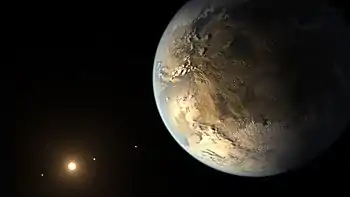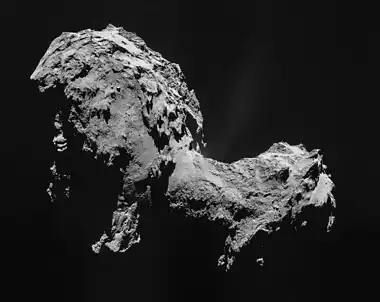(163132) 2002 CU11
(163132) 2002 CU11, provisional designation 2002 CU11, is a bright, sub-kilometer asteroid, classified as near-Earth object and potentially hazardous asteroid of the Apollo group.[2] Based on absolute magnitude, it is the second largest asteroid known to have passed closer than the Moon.[5]
| Discovery[1] | |
|---|---|
| Discovered by | LINEAR |
| Discovery date | 7 February 2002 |
| Designations | |
| (163132) 2002 CU11 | |
| NEO · PHA · Apollo[2] | |
| Orbital characteristics[2] | |
| Epoch 13 January 2016 (JD 2457400.5) | |
| Uncertainty parameter 0 | |
| Observation arc | 4600 days (12.59 yr) |
| Aphelion | 1.5795 AU (236.29 Gm) |
| Perihelion | 0.85959 AU (128.593 Gm) |
| 1.2196 AU (182.45 Gm) | |
| Eccentricity | 0.29517 |
| 1.35 yr (491.94 d) | |
| 47.609° | |
| 0° 43m 54.48s / day (n) | |
| Inclination | 48.782° |
| 157.77° | |
| 110.54° | |
| Earth MOID | 0.00189035 AU (282,792 km) |
| Physical characteristics | |
Mean diameter | 0.460±0.017 km[2][3] 0.730 km (assumed)[4] |
| Mass | 5.3×1011 kg (assumed) |
| 0.408±0.061[2] | |
| 18.5[2] | |
Description
2002 CU11 was discovered on 7 February 2002 by Lincoln Near-Earth Asteroid Research (LINEAR) at an apparent magnitude of 19 using a 1.0-meter (39 in) reflecting telescope.[1] It has an estimated diameter of 730 meters (2,400 ft).[4] The asteroid was listed on Sentry Risk Table with a Torino Scale rating of 1 on 20 March 2002.[4]
With an observation arc of 44 days, (163132) 2002 CU11 showed a 1 in 9,300 chance of impacting Earth in 2049.[6] It was removed from the Sentry Risk Table on 26 April 2002.[7] It is now known that on 3 September 2049 the asteroid will be 0.0843 AU (12,610,000 km; 7,840,000 mi) from Earth.[8]
Even though using an epoch of 27 June 2015 gives 2002 CU11 an Earth-MOID of 0.0000093 AU (1,390 km; 860 mi),[2] the asteroid does not make any threatening approaches to Earth in the foreseeable future.
| Date | Distance from Earth |
|---|---|
| 1925-08-30 | 0.0023 AU (340,000 km; 210,000 mi) |
| 2014-08-30 | 0.0346 AU (5,180,000 km; 3,220,000 mi) |
| 2049-09-03 | 0.0843 AU (12,610,000 km; 7,840,000 mi) |
| 2080-08-31 | 0.0042 AU (630,000 km; 390,000 mi) |
The close approach of 2080 will cause an uncertainty of 4 minutes for the close approach time of 2084.[8]
| PHA | Date | Approach distance in lunar distances | Abs. mag (H) |
Diameter (C) (m) |
Ref (D) | ||
|---|---|---|---|---|---|---|---|
| Nominal(B) | Minimum | Maximum | |||||
| (152680) 1998 KJ9 | 1914-12-31 | 0.606 | 0.604 | 0.608 | 19.4 | 279–900 | data |
| (458732) 2011 MD5 | 1918-09-17 | 0.911 | 0.909 | 0.913 | 17.9 | 556–1795 | data |
| (163132) 2002 CU11 | 1925-08-30 | 0.903 | 0.901 | 0.905 | 18.5 | 443–477 | data |
| 69230 Hermes | 1937-10-30 | 1.926 | 1.926 | 1.927 | 17.5 | 700-900[9] | data |
| 69230 Hermes | 1942-04-26 | 1.651 | 1.651 | 1.651 | 17.5 | 700-900[9] | data |
| 2017 NM6 | 1959-07-12 | 1.89 | 1.846 | 1.934 | 18.8 | 580–1300 | data |
| (27002) 1998 DV9 | 1975-01-31 | 1.762 | 1.761 | 1.762 | 18.1 | 507–1637 | data |
| 2002 NY40 | 2002-08-18 | 1.371 | 1.371 | 1.371 | 19.0 | 335–1082 | data |
| 2004 XP14 | 2006-07-03 | 1.125 | 1.125 | 1.125 | 19.3 | 292–942 | data |
| 2015 TB145 | 2015-10-31 | 1.266 | 1.266 | 1.266 | 20.0 | 620-690 | data |
| (137108) 1999 AN10 | 2027-08-07 | 1.014 | 1.010 | 1.019 | 17.9 | 556–1793 | data |
| (153814) 2001 WN5 | 2028-06-26 | 0.647 | 0.647 | 0.647 | 18.2 | 921–943 | data |
| 99942 Apophis | 2029-04-13 | 0.0981 | 0.0963 | 0.1000 | 19.7 | 310–340 | data |
| 2017 MB1 | 2072-07-26 | 1.216 | 1.215 | 2.759 | 18.8 | 367–1186 | data |
| 2011 SM68 | 2072-10-17 | 1.875 | 1.865 | 1.886 | 19.6 | 254–820 | data |
| (163132) 2002 CU11 | 2080-08-31 | 1.655 | 1.654 | 1.656 | 18.5 | 443–477 | data |
| (416801) 1998 MZ | 2116-11-26 | 1.068 | 1.068 | 1.069 | 19.2 | 305–986 | data |
| (153201) 2000 WO107 | 2140-12-01 | 0.634 | 0.631 | 0.637 | 19.3 | 427–593 | data |
| (276033) 2002 AJ129 | 2172-02-08 | 1.783 | 1.775 | 1.792 | 18.7 | 385–1242 | data |
| (290772) 2005 VC | 2198-05-05 | 1.951 | 1.791 | 2.134 | 17.6 | 638–2061 | data |
| (A) This list includes near-Earth approaches of less than 2 lunar distances (LD) of objects with H brighter than 20. (B) Nominal geocentric distance from the center of Earth to the center of the object (Earth has a radius of approximately 6,400 km). (C) Diameter: estimated, theoretical mean-diameter based on H and albedo range between X and Y. (D) Reference: data source from the JPL SBDB, with AU converted into LD (1 AU≈390 LD) (E) Color codes: unobserved at close approach observed during close approach upcoming approaches | |||||||
References
- "MPEC 2002-C44 : 2002 CU11". IAU Minor Planet Center. 8 February 2002. Retrieved 18 September 2013. (K02C11U)
- "JPL Small-Body Database Browser: 163132 (2002 CU11)" (2010-08-11 last obs and observation arc=8.5 years). Jet Propulsion Laboratory. Archived from the original on 28 May 2019. Retrieved 7 April 2016.
- "LCDB Data for (163132) 2002 CU11". Asteroid Lightcurve Database (LCDB). Retrieved 16 June 2020.
- "Current Impact Risks (2002 CU11)". Near-Earth Object Program. NASA. 21 March 2002. Archived from the original on 21 March 2002.
- NEO Earth Close Approaches @ JPL CNEOS
Select "Nominal dist <= 1 LD", "Past only", Sort by "H (mag)" - Andrea Milani; Giovanni Valsecchi & Maria Eugenia Sansaturio (2002). "The problem with 2002 CU11". Spaceguard / Tumbling Stone. Archived from the original on 4 March 2016. Retrieved 18 September 2013.
- "Date/Time Removed". NASA/JPL Near-Earth Object Program Office. Archived from the original on 2 June 2002. Retrieved 18 September 2013.
- "JPL Close-Approach Data: 163132 (2002 CU11)" (2010-08-11 last obs and observation arc=8.5 years). Retrieved 18 September 2013.
- Marchis, F.; et al. "Multiple asteroid systems: Dimensions and thermal properties from Spitzer Space Telescope and ground-based observations". Icarus. 221 (2): 1130–1161. Bibcode:2012Icar..221.1130M. doi:10.1016/j.icarus.2012.09.013. Retrieved 24 August 2018.
External links
- (163132) 2002 CU11 at NeoDyS-2, Near Earth Objects—Dynamic Site
- (163132) 2002 CU11 at ESA–space situational awareness
- (163132) 2002 CU11 at the JPL Small-Body Database


